ikfoundation.org
The IK Foundation
Promoting Natural & Cultural History
Since 1988


 Crowdfunding Campaign
Crowdfunding Campaignkeep knowledge open, connected, and growing on this textile history resource...
THE SHIRT FACTORY
– Trade, Employees & Fashion in Whitby: 1870s to 1910s
Dressmakers, milliners, seamstresses and needlewomen worked in differing conditions, even in a town as small as Whitby, depending on their knowledge, experience and contacts. A well-trained local worker could set up a business independently or find work with one of the local draperies or dressmakers. It was the same for milliners. Against that, many dressmakers worked at home sewing for their close family or a circle of friends; this is obvious since most of the censuses contained more than 150 women declaring themselves to be dressmakers. They would often be daughters living at home who could, in this way, make a respectable contribution to the support of their family while still available to help with the housework. However, a group of women also worked at a local shirt factory, existing over a 40-year period, which this essay will look closer at.
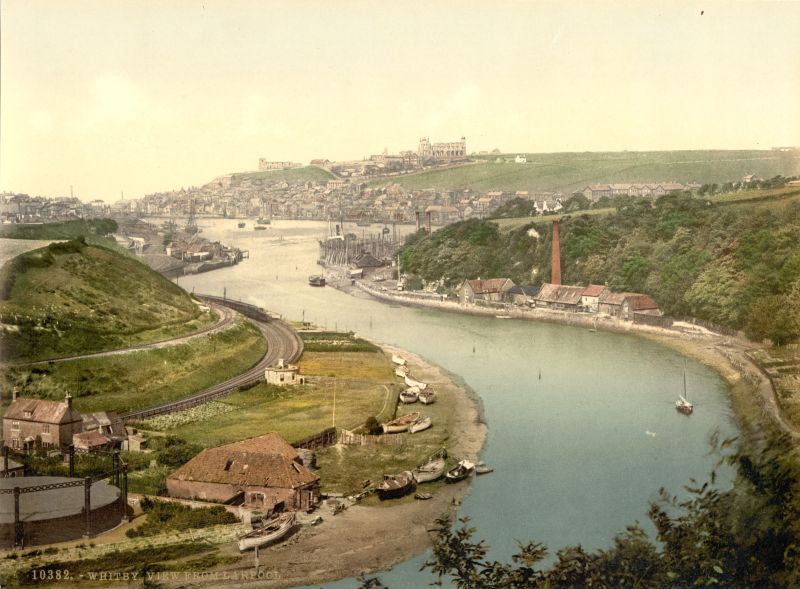 Bulmer’s local directory of 1890 gives a detailed list of milliners and dressmakers who either worked on their own or employed other similar workers. The directory also states, 'In 1875 a shirt factory was opened by Mr George Remmer, at Spital Bridge, which now employs between 40 and 50 hands.’ A matter corroborated by the 1891 census, which listed many women engaged in shirt-sewing. Interestingly, this coloured view of Whitby and the River Esk gives an idea of the location of Remmer’s Shirt Factory, even if it is not visible in the picture. Still, it was located just the right behind the shipbuilding yard in the right-middle of the photograph.|Whitby, Yorkshire, England, 1890-1900. (Courtesy: Library of Congress. No: 09085. Originally published by Detroit Publishing Company, 1905. Public Domain).
Bulmer’s local directory of 1890 gives a detailed list of milliners and dressmakers who either worked on their own or employed other similar workers. The directory also states, 'In 1875 a shirt factory was opened by Mr George Remmer, at Spital Bridge, which now employs between 40 and 50 hands.’ A matter corroborated by the 1891 census, which listed many women engaged in shirt-sewing. Interestingly, this coloured view of Whitby and the River Esk gives an idea of the location of Remmer’s Shirt Factory, even if it is not visible in the picture. Still, it was located just the right behind the shipbuilding yard in the right-middle of the photograph.|Whitby, Yorkshire, England, 1890-1900. (Courtesy: Library of Congress. No: 09085. Originally published by Detroit Publishing Company, 1905. Public Domain).From a general local perspective, the 1891 census shows a similar number of female workers (243) employed in the sewing trades compared with earlier decades, though the list now includes a long line of new occupational categories in accordance with the expanding scope of the shirt factory. Working in this factory were 17 shirt seamstresses and one each of the following: shirt factory machinist, shirt plain sewing, shirt factory hand, shirt maker, shirt quiltress, shirt seamstress & knitter, shirt sewing, shirt sewing machinist, shirt sewing woman, and underclothing/shirtmaker. Most likely, a dressmaker machinist and several more dressmakers and seamstresses were also employed on the premises of Remmer’s Shirt Factory at Spital Bridge or engaged by him to sew shirts at home. Thus, as many as 40 or 50 people may well have been employed, full-time or part-time, by this firm described in the directory the previous year.
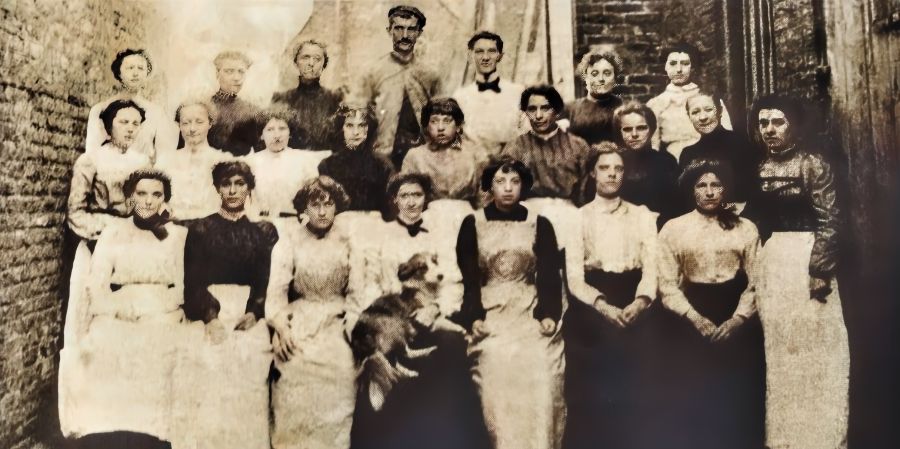 This unique photograph depicted the staff at Remmer’s Shirt Factory around 1906, showing that most seamstresses were young women. It was included in Whitby Gazette in the autumn of 1984 when it was noted: ‘The young women in this formal group were all employees of Remmer’s Shirt Factory, at Olive Buildings, Spital Bridge, Whitby about 78 years ago.’ (Collection: Whitby Museum, Library & Archive, Whitby Gazette 14 Sept. 1984).
This unique photograph depicted the staff at Remmer’s Shirt Factory around 1906, showing that most seamstresses were young women. It was included in Whitby Gazette in the autumn of 1984 when it was noted: ‘The young women in this formal group were all employees of Remmer’s Shirt Factory, at Olive Buildings, Spital Bridge, Whitby about 78 years ago.’ (Collection: Whitby Museum, Library & Archive, Whitby Gazette 14 Sept. 1984).The census registered five years prior to the photograph above – the 1901 census – shows that Remmer’s Shirt Factory at Spital Bridge had some 40 women involved in its activities. The following categories of workers can be traced to this factory:
- Seamstress, Shirt 15 women
- Seamstress, Shirt, retired 1
- Machinist in Shirt Factory 2
- Needlewoman, Shirt 1
- Needlework Shirt 1
- Plain Sewing Shirt & Knitter 1
- Shirt Button Hole Maker 2
- Shirt Finisher 1
- Shirt Machinist 4
- Shirtmaker 15
- Shirtmaker Machinist 1
- Working at Shirt Factory 1
It cannot be definitely stated that all those recorded under ‘Seamstress, shirt’ were employed by Mr Remmer, but this was probably the best source of livelihood for a Whitby seamstress at this time. The factory had presumably now increased its rate of production to some extent, with rather more employees at a time when sewing machines were still developing and improving with every decade. This census also shows a number of new specialisations for women, who now made button-holes, worked as ‘finishers’ or added embroidery to shirts. Those working in the shirt factory were overwhelmingly young, with only a few over thirty and most under twenty. The owner, 51-year-old George Remmer, a Shirtmaker living at Spital Bridge, himself features in the census. Meanwhile, the shirt seamstresses working at home were, on average, appreciably older than those working at the factory, with 8 of the 15 active aged over fifty.
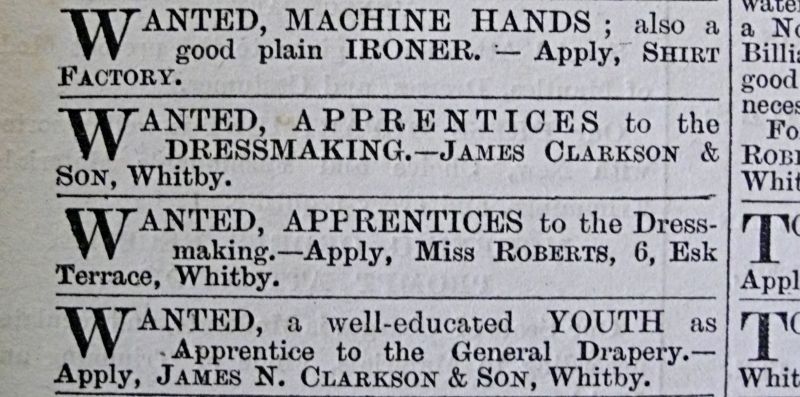 The ‘Shirt Factory’, which seems to have been in most need of new workers during 1895-1914; for example, in spring 1895: ‘Wanted, Machine Hands; also a good plain Ironer. – Apply, Shirt Factory’, depicted at the top of this advert. In the spring of 1900, the firm was looking for ‘3 Good Button-Hole Workers’, and several times in 1914, it was instead searching for ‘Laundry Hands’. (Collection: Whitby Museum, Library & Archive, Whitby Gazette, spring 1895).
The ‘Shirt Factory’, which seems to have been in most need of new workers during 1895-1914; for example, in spring 1895: ‘Wanted, Machine Hands; also a good plain Ironer. – Apply, Shirt Factory’, depicted at the top of this advert. In the spring of 1900, the firm was looking for ‘3 Good Button-Hole Workers’, and several times in 1914, it was instead searching for ‘Laundry Hands’. (Collection: Whitby Museum, Library & Archive, Whitby Gazette, spring 1895).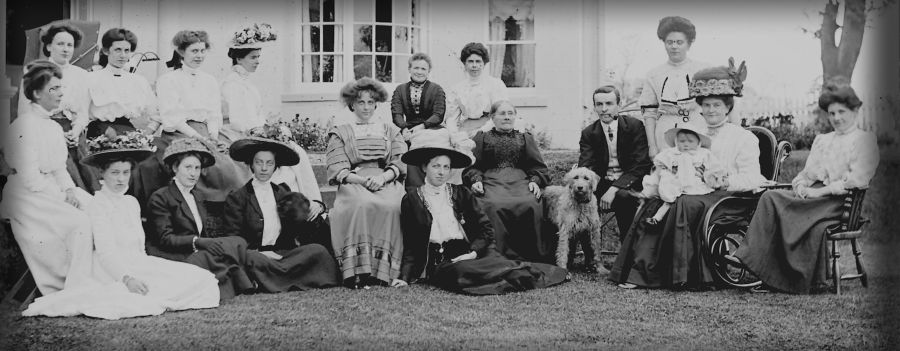 Running a shirt factory in a small town like Whitby must have been very good business at the time, with white shirts or blouses for women very popular in the 1890s and through the Edwardian period. The white blouse could serve equally well as informal daywear or as an indispensable garment combined with a dark skirt for working women. Here, it is visualised with the well-to-do Botham family in their garden at their house c.1907 in Whitby. Notice that most women in the photograph wear white shirts or blouses. (Courtesy: Whitby Museum, Photographic Collection, 2002/13.7. Part of photograph (Whitby Lit. & Phil.).
Running a shirt factory in a small town like Whitby must have been very good business at the time, with white shirts or blouses for women very popular in the 1890s and through the Edwardian period. The white blouse could serve equally well as informal daywear or as an indispensable garment combined with a dark skirt for working women. Here, it is visualised with the well-to-do Botham family in their garden at their house c.1907 in Whitby. Notice that most women in the photograph wear white shirts or blouses. (Courtesy: Whitby Museum, Photographic Collection, 2002/13.7. Part of photograph (Whitby Lit. & Phil.). 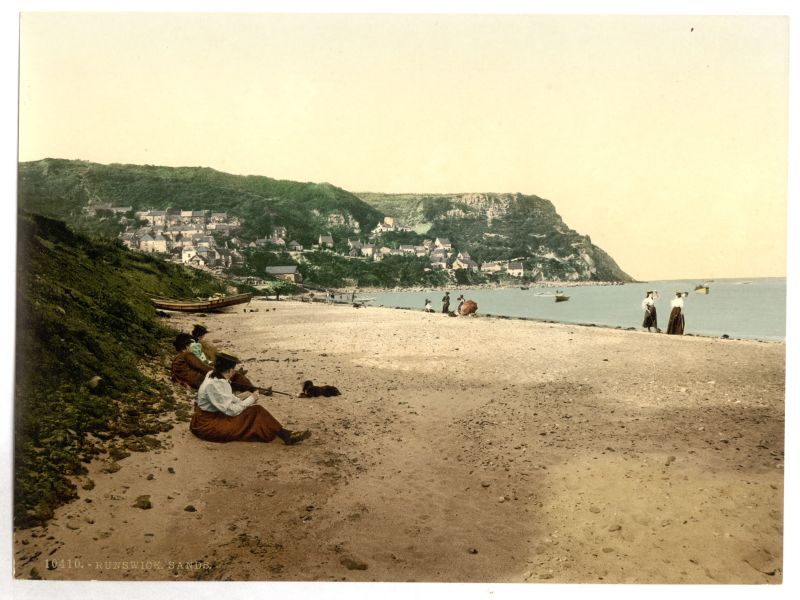 A second example of the popularity of white shirts came to be visualised in this photograph taken around the year 1900 along the beach south of the village Runswick Bay, about ten kilometres north of Whitby. (Courtesy: Library of Congress. No: 09088. Originally published by Detroit Publishing Company, 1905. Public Domain).
A second example of the popularity of white shirts came to be visualised in this photograph taken around the year 1900 along the beach south of the village Runswick Bay, about ten kilometres north of Whitby. (Courtesy: Library of Congress. No: 09088. Originally published by Detroit Publishing Company, 1905. Public Domain).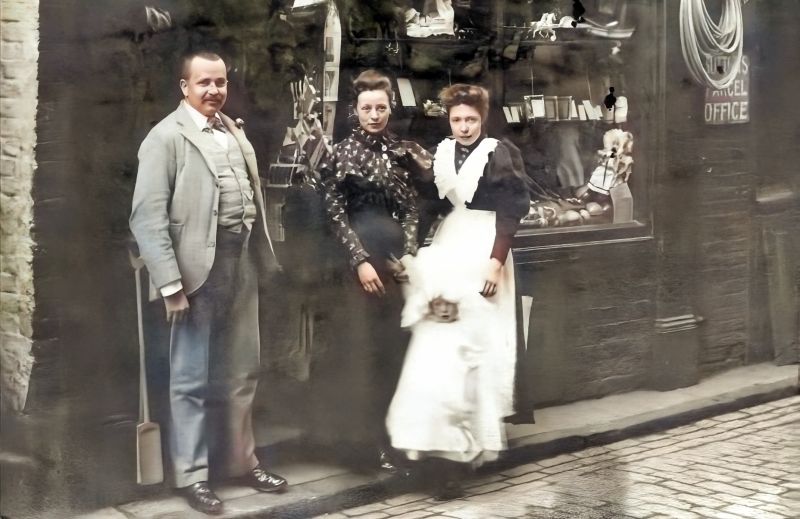 A third photograph also demonstrates that some women favoured coloured shirts with printed motifs in a fashionable style or, by regulations, a black shirt as part of a working uniform. Here exemplified with two young ladies together with a small child and, probably, the shop’s owner outside a general dealer selling baskets, porcelain, etc., in Baxtergate, Whitby, photograph about 1902. Garments of this kind may well have been made locally at Remmer’s Shirt Factory. (Whitby Museum, Photographic Collection, W 4335. Whitby Lit. & Phil. Modern digital colouring of the old picture).
A third photograph also demonstrates that some women favoured coloured shirts with printed motifs in a fashionable style or, by regulations, a black shirt as part of a working uniform. Here exemplified with two young ladies together with a small child and, probably, the shop’s owner outside a general dealer selling baskets, porcelain, etc., in Baxtergate, Whitby, photograph about 1902. Garments of this kind may well have been made locally at Remmer’s Shirt Factory. (Whitby Museum, Photographic Collection, W 4335. Whitby Lit. & Phil. Modern digital colouring of the old picture).The shirt factory founded in 1875 at Spital Bridge had shrunk in size around 1910 compared to the previous decade. White shirts or blouses were still extremely popular for women, but increased competition from larger factories elsewhere may have reduced the demand for Remmer’s local products. Those workers in the 1911 census who can be directly linked to Remmer’s were (one in each case unless otherwise stated) Button Hole workers, Shirt Factory, Machine Hand in Shirt Factory, Sewing Machinist Linen, Sewing Machinist Shirt Maker, Shirt Factory workers, Shirt Maker (2), and Starcher – a total of nine young to middle-aged women. Eight seamstresses aged between 30 and 72 are listed this year, some of them perhaps also involved in shirt-making. A 1907 announcement in the Whitby Gazette also reveals that George Remmer was now supplementing his shirt factory with an offshoot: ‘G. Remmer, Helredale Steam Laundry... in connection with the Shirt Factory...’ This business description is repeated in the 1911 census: ‘Laundry Proprietor George Remmer 61 years and Louise Anna Remmer 57 years, Assisting in the business, Helredale Steam Laundry Spital Bridge.’ This new addition to the factory was no doubt an opportunity for Remmer and his wife to continue shirt-sewing on a lesser scale while making room for the steam laundry, a very suitable development in the Edwardian era, considering the need of frequent washing and ironing for popular light-weight and light-coloured cotton clothes, and the flourishing Whitby hotel trade that, particularly during the holiday season, increasingly required the bedclothes, table linen and towels, etc., used by its guests to be washed and pressed in a professional manner.
Sources:
- Bulmer, T. & Ashton-On Ribble Co. T. Snape & Co Printers 1890, Bulmer’s History and Directory of North Yorkshire 1890.
- Cook, W. J. & Co., Whitby and District Directory, Whitby 1901.
- Hansen, Viveka, The Textile History of Whitby 1700-1914 – A lively coastal town between the North Sea and North York Moors’, London & Whitby 2015 (pp. 119, 187, 194-202 & 301).
- Whitby Museum (Whitby Lit. & Phil.), Whitby, United Kingdom. | Library & Archive (Whitby Gazette, original papers.| Photographic Collection (Sutcliffe collection & other local photographs). | Research made during the years 2006-2012.
- Whitby, North Yorkshire County Library, United Kingdom (Research made in 2006 of Census 1851-1901, microfilm & 1911 online in 2011).
More in Books & Art:
Essays
The iTEXTILIS is a division of The IK Workshop Society – a global and unique forum for all those interested in Natural & Cultural History.
Open Access Essays by Textile Historian Viveka Hansen
Textile historian Viveka Hansen offers a collection of open-access essays, published under Creative Commons licenses and freely available to all. These essays weave together her latest research, previously published monographs, and earlier projects dating back to the late 1980s. Some essays include rare archival material — originally published in other languages — now translated into English for the first time. These texts reveal little-known aspects of textile history, previously accessible mainly to audiences in Northern Europe. Hansen’s work spans a rich range of topics: the global textile trade, material culture, cloth manufacturing, fashion history, natural dyeing techniques, and the fascinating world of early travelling naturalists — notably the “Linnaean network” — all examined through a global historical lens.
Help secure the future of open access at iTEXTILIS essays! Your donation will keep knowledge open, connected, and growing on this textile history resource.
been copied to your clipboard




– a truly European organisation since 1988
Legal issues | Forget me | and much more...
You are welcome to use the information and knowledge from
The IK Workshop Society, as long as you follow a few simple rules.
LEARN MORE & I AGREE







